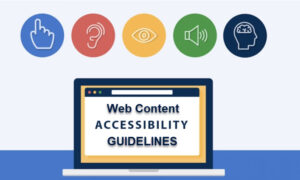These were published way earlier but it was revised again in 2018 by the WCAG Working Group. The WCAG Working Group published the latest set. In the latest, they talked about mobility and websites that can do things that should follow these principles.
There are 4 Fundamental Principles: Also known as POUR Principles.
1) Perceivable
2) Operable
3) Understandable and
4) Robust
- Perceivable
Users must be able to perceive the information being presented in a way that all users can recognize and understand. When a person cannot perceive the content, the page is not accessible. For example, WCAG requires pre-recorded videos to have transcripts or closed captions so that users with hearing disabilities can perceive the audio content as equally well as users without disabilities. Most people perceive Web content through sight and sound. When content is communicated exclusively through one sense, some people will not be able to perceive it. Other perceivability concerns under WCAG include the use of high-contrast color schemes and the ability to resize text, so that people with low vision can successfully use and navigate your site.
- Operable
Something is functional using a keyboard. If functional items are not keyboard operable, they will be inaccessible to many users.
There are four “operable” guidelines:
- Make it possible to perform all tasks with a keyboard instead of a mouse.
- Give users enough time to perform tasks.
- Avoid information that flashes or flickers, as it may trigger seizures.
- Make it possible for users to navigate, find content, and figure out where they are.
- Understandable
Content that is understandable can be read and comprehended by users without undue effort. This means that the content should be understandable both by the users themselves and by assistive technologies such as screen readers. For most content, this means simply avoiding overly complex sentences and jargon, and providing clear layout and design. For some complex content such as medical information, separate, easy-to-read information may be necessary. Although technological change has not affected it as much as the other three WCAG principles, making your website understandable remains a core obligation for internet accessibility.
Anything that is in plain English should be written in such a way that user is able to
understand that information. It should be easy. You don’t say “authentication” or “authorization”. All
these are technical terms. You can say “access”. That is simple. An example is “Access. to the website is not available as you do not register to this website. Please register to
gain access.” So now it would be like user saying to themselves,
“Oh, to access the information further, I need to register. Go it” If it says, “You are not authenticated.” or “You are not authorized.” Technical terminology should not be used if use should translate to users’ level under stable words such as
register.”. The word register is much simpler than Authentication
- Robust
Robustness, as defined by WCAG, refers specifically to web content that is compatible with a variety of “user agents”: browsers, assistive technologies, and other means of accessing web content.

We at Solutions UIUX are making innovative and disruptive software solutions for companies *SMB’s & startups that yearn to help humanity reach to the next level of Transformation!
We are a dynamic team of talented individuals, both abled and disabled, working collaboratively from different parts of the world!
If your organization has any needs with Web Content Accessibility, we can help. Please reach out to us at Info@SolutionsUIUX.com or visit our website to find more details www.solutionsuiux.com
Reference: Web Content Accessibility Guidelines from Web Accessibility Initiative.


Recent Comments